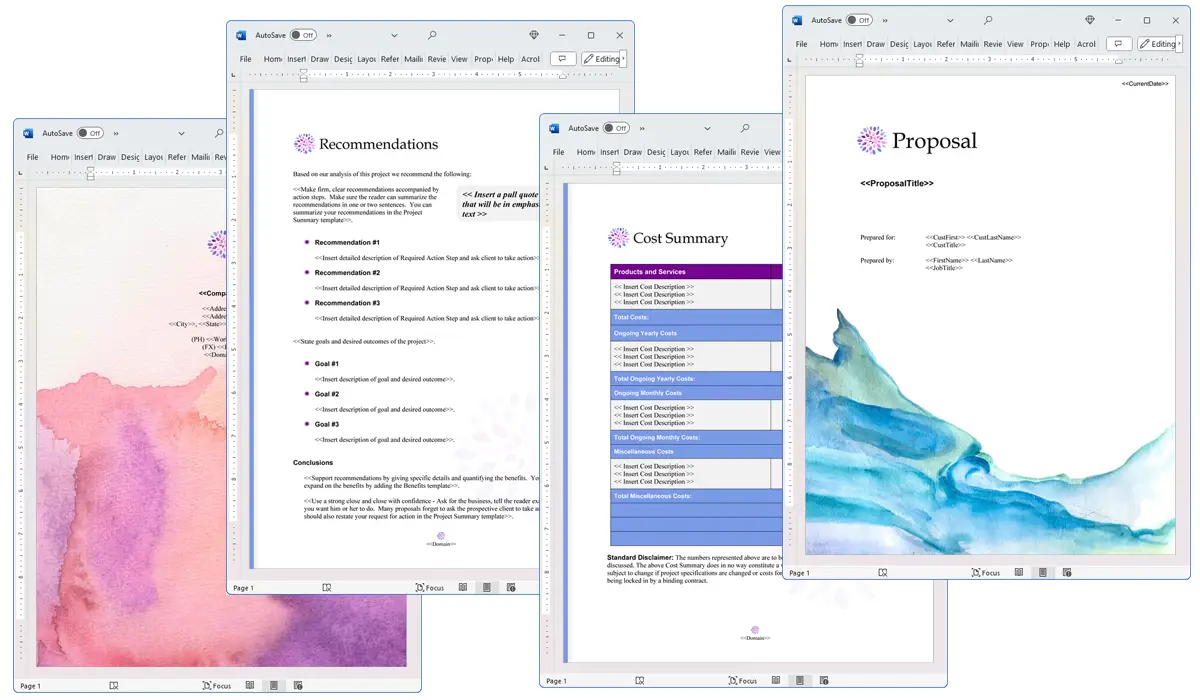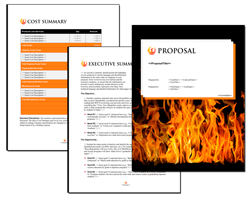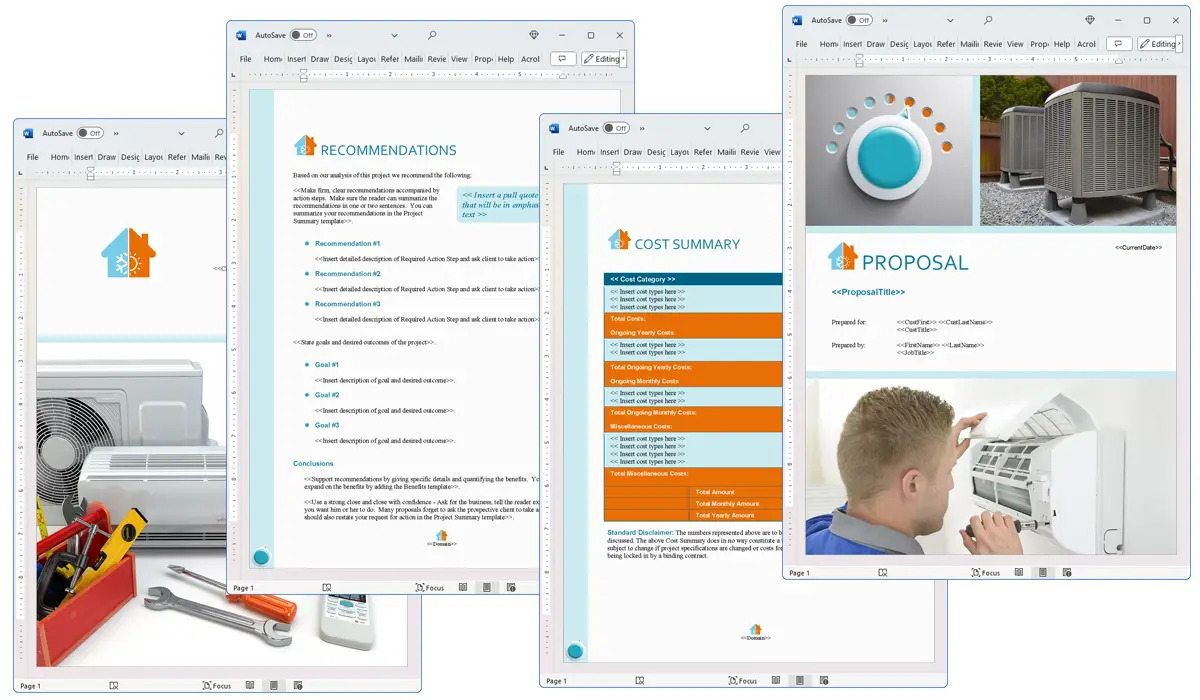What is the Documentation Requirements chapter used for?
Proposal Kit Professional Bundle adds more design themes, all six Contract Packs,
a project management library, and Expert Edition software.

Illustration of Proposal Pack Artsy #9
We include this Documentation Requirements chapter template in every Proposal Pack, along with thousands more. You assemble this chapter with others in various combinations to create custom-tailored business proposals, plans, reports, and other documents. Proposal Packs apply custom visual designs to the templates, giving the final documents a consistent professional finish.
 DOWNLOADABLE, ONE-TIME COST, NO SUBSCRIPTION FEES
DOWNLOADABLE, ONE-TIME COST, NO SUBSCRIPTION FEES
Overview of the Documentation Requirements Chapter
The Documentation Requirements chapter is a part of many business proposal documents, particularly in fields where clear, detailed documentation is crucial. This chapter serves to outline and specify the types of documentation that a vendor promises to provide to the client upon project completion or during its execution. Proper documentation can encompass a wide range of materials, including software and hardware manuals, standards certifications, operational procedures, and more. Ensuring that these elements are clearly defined from the outset helps to set proper expectations and can prevent misunderstandings between parties involved.
How is the Documentation Requirements Chapter Used?
When used in a business proposal, the Documentation Requirements chapter is used to clearly define what documentation will be provided as part of the agreement. This can be particularly important in complex projects, where the documentation serves not only as a user guide but also as a legal safeguard or compliance measure. By explicitly stating what documents will be supplied, companies can demonstrate their professionalism and commitment to transparency, which can be a decisive factor in winning a contract.
What is Included in the Documentation Requirements Chapter?
Typically, the Documentation Requirements chapter includes:
- List of Documents: A detailed list of all documents to be provided, such as training manuals, system architecture diagrams, compliance certificates, and maintenance schedules.
- Purpose of Each Document: An explanation of the relevance and use of each document, helping the client understand why each is necessary.
- Format and Delivery Method: Information on how the documents will be formatted (e.g., digital, printed) and the method of delivery (e.g., email, physical delivery).
- Timeline for Delivery: A timeline indicating when each document will be available, aligning with project milestones or completion stages.
- Standards and Compliance: Details on any industry standards or regulatory compliance that the documentation will adhere to.
Use Case Examples for the Documentation Requirements Chapter
- Technical Proposals: For proposals requiring detailed technical specifications, such as in IT infrastructure projects, to ensure all technical aspects are well-documented.
- Evaluation Proposals: In proposals that involve assessment or evaluation, documentation like scoring rubrics and criteria justification can be outlined.
- Government Contracts: Where strict adherence to documentation standards is often required for compliance and auditing purposes.
- Healthcare Industry: Proposals related to healthcare might detail patient care protocols, equipment manuals, and compliance with health regulations.
- Construction and Engineering: In these fields, proposals might include safety manuals, structural assessments, and certification documents.
Key Takeaways
- The Documentation Requirements chapter helps define the scope and specifics of documentation to be provided in a proposal.
- It enhances transparency and professionalism in business engagements.
- Properly outlined Documentation Requirements can prevent potential misunderstandings and disputes.
- This chapter is especially crucial in technically complex, regulated, or compliance-heavy industries.
- It provides a structured approach to outline and deliver necessary documents to clients, aligning with project goals and legal requirements.

Illustration of Proposal Pack Symbols #10
 What Our Clients Say
What Our Clients SayEarlier this year I submitted my first RFP bid and was very excited to find this wonderful product. The professional quality of the Contemporary Proposal Kit along with the Wizard helped win my current contract. Both were very intuitive and made writing a snappy proposal much easier."
Workforce Development Coordinator
Columbia River Inter-Tribal Fish Commission
 4.7 stars, based on 849 reviews
4.7 stars, based on 849 reviewsRelated Chapters
Samples Using the Documentation Requirements Chapter
Document Layouts Using the Documentation Requirements Chapter

The Documentation Requirements chapter and other chapters are integrated into a Word document as illustrated here in the Proposal Pack HVAC #2 design theme. There are hundreds of design themes available, and every design theme includes the Documentation Requirements chapter template.
A proper business proposal will include multiple chapters. This chapter is just one of many you can build into your proposal. We include the complete fill-in-the-blank template in our Proposal Pack template collections. We also include a library of sample proposals illustrating how companies in different industries, both large and small, have written proposals using our Proposal Packs. This template will show you how to write the Documentation Requirements.
We include a chapter library for you to build from based on your needs. All proposals are different and have different needs and goals. Pick the chapters from our collection and organize them as needed for your proposal.
Using the Proposal Pack template library, you can create any business proposal, report, study, plan, or document.
The Wizard software includes an AI Writer, which will write the content of this and any other chapter of your document. Use the AI Writer to do the heavy lifting, writing the first draft of your proposal or business document in minutes.
 Ian Lauder has been helping businesses write their proposals and contracts for two decades. Ian is the owner and founder of Proposal Kit, one of the original sources of business proposal and contract software products started in 1997.
Ian Lauder has been helping businesses write their proposals and contracts for two decades. Ian is the owner and founder of Proposal Kit, one of the original sources of business proposal and contract software products started in 1997.By Ian Lauder
 Published by Proposal Kit, Inc.
Published by Proposal Kit, Inc.


 Cart
Cart
 Facebook
Facebook YouTube
YouTube Bluesky
Bluesky Search Site
Search Site